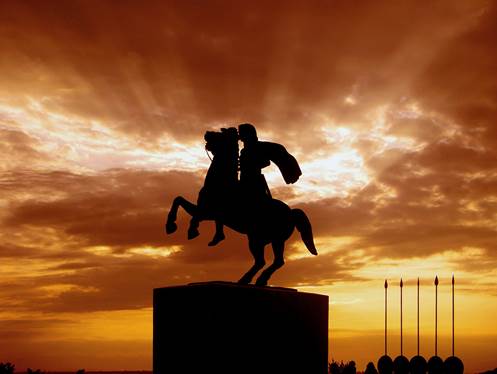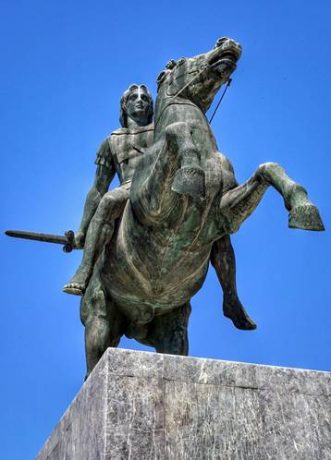From the cradle, Alexander, the son of King Philip II, was a born leader in Pella, Macedonia (356 BC). From his days of martial arts training, the young prince showed exemplary leadership skills that earned him the alias, “The Great.” Following the death of the ruling king, the crown prince battled with internal opposition and emerged victorious in the first face of his reign.
He had Greece under his control while aiming for the conquest to acclaim Achaemenid. After his successful reign, the commander had the countryside covering a 5.2m square kilometers landscape (the strongest and famous rule in history). These are great feats of Alexander the Great – recording his befitting military campaign, exemplary leadership skills, and strategies with which he ran the powerful Greek people.
#I: The Chaeronea Battle And Defeat Of Sacred Band (338 BC)
This is recorded as one of the greatest accomplishments of Alexander because his father’s reign attracted a lot of threats from a few states in Greece. Primarily, the pressure from Thebes and Athens fueled the Chaeronea battle in 338BC right in Greece’s central (Boeotia). Being a young prince of barely 18 years, he played an important role by strategically leading the left-wing troops as he secured victory.
He led the Calvary wing, which defeated the indestructible Sacred Band of Thebes. This victory did not only make his father a proud ruler but also placed the city in a commanding position. Of course, the victory of the elite corps paved the way for his future reign in Greece. Making the citizens of his city and its surroundings highly expectant of the next battle he would lead.
 #II: Series Of Wars Leading To Control Over Greece (335 BC)
#II: Series Of Wars Leading To Control Over Greece (335 BC)
Before the great Alexander began his Asian campaign, he had a strategy to secure his Northern frontiers. Following this strategy, he headed north this year and defeated the Thracian revolt led by the rulers of Glaukias, Illyria, Taulantii, and others. These were the first few wars that began the short series of swift battles emerging his reign over Greece. As the king of Macedonia, he led the troops that kept Thebes in its place after revolving again.
The stories of the numerous victories of the Persian empire army spread across cities to Egypt. Victory from these battles finally brought the whole of Greece to their senses as they accepted his rule over them. In the space of two years, he emerged the commanding and control of Greece. The outcome of these two years reassured his plans and efforts in Asia.
#III: Battle Of The Granicus River – The Conquest Of Achaemenid I (334 BC)
The first battle over the Achaemenid founded by Cyrus was termed ‘Battle of the Granicus River.’ As Alexander sailed, several Satrap troops patiently awaited his arrival at the town of Zelea. The two forces crossed paths and fought at the shore of River Granicus. Alexander being a strategic thinker, already took advantage of their numbers over the satraps as they immersed their chariots into the soil.
For the next few battles, he and his army leveraged on this technique near the River Granicus when fighting other wars. He strategically pressed the left with briskness, drove a direct hole through the enemy’s squad with his wedge formation, as he made his final strike to their army. This technique earned Alexander the lives of a few nobles by either his sword or his companions.
#IV: Battle Of Issus – The Conquest Of Achaemenid II (333 BC)
The actions of Darius III in cutting out the Greek line of supply instigated the battle of Issus. King Darius put together one of his largest warriors, setting up war with Alexander’s troops in the south of Issus. Since Darius wasn’t as strategic as the opponent has always been, he never envisaged the river advantage. He took the battle near river Pinarus where Alexander was obviously on favorable ground.
With this much advantage handed to the Greek army, they attacked Darius and his fighters from the left side up to the hill. Thankfully for Darius and his army, they settled for a retreat at the slightest opportunity handed to them by the opposition. The elite Calvary and Alexander then launched a massive attack on their forces, which made them flee. This battle was recorded as one of his breakthroughs that led to his campaign over Persia.
#V: Battle Of Gaugamela – The Conquest Of Achaemenid III (331 BC)
Crossing the Euphrates and Tigris led Alexander closely to the heart of Achaemenid. At this time, Darius The Third had a massive force awaiting him from his east satraps. The two forces had face-to-face combat that resulted in the infamous Battle of Gaugamela. As expected, the king had a plan for the division of his forces; he set them apart into equal halves. Making one half to the right commanded by himself, and the other to the left led by his friend, Parmenion.
For the wrong reasons, Darius was found right in the center of the king’s infantry. As though it has been planned for years, the Greek forces attacked the center of their opponents. Since the center was now the weakest link of the opposition, Alexander formed a wedge around the force. When the line collapsed, Darius wasn’t left with that much of a choice than to flee like his predecessor with his heavy losses.
Conclusion
The reign of Alexander and his army held a glorious terrain that is still very much alive today. Irrespective of the numerous oppositions he faced by the rulers of Persia, the king stood strong as he commanded his troops to victory most times. The Phalanx was one major instrument used by his forces in breaking the tactical defense mechanism set by his opposition. To date, history still keeps a strong record and reference to his leadership and achievements.


 #II: Series Of Wars Leading To Control Over Greece (335 BC)
#II: Series Of Wars Leading To Control Over Greece (335 BC)
